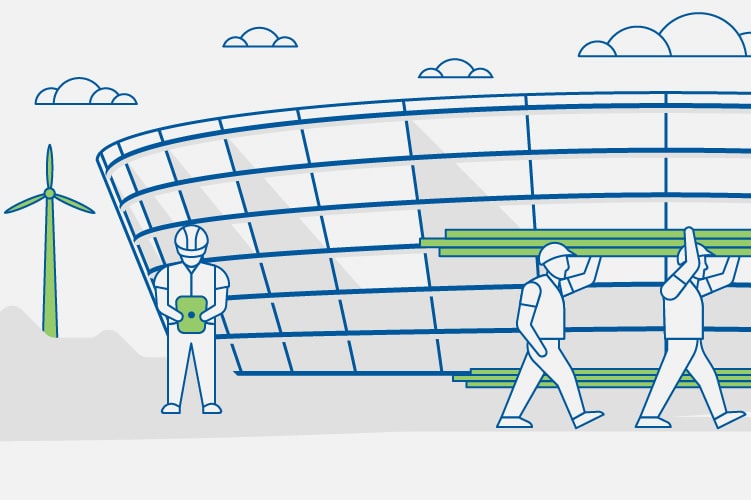With more companies focusing on environmental sustainability, “green” construction practices are increasingly popular.
In fact, according to Stefanie Young, vice president, client solutions at the U.S. Green Building Council (USGBC), sustainability in construction has never been more important.
“Buildings account for nearly 40% of global energy-related CO2,” Young said. Making changes to industry legislation and common construction practices will play a vital role in helping countries, states and communities meet climate-change goals. “We can’t make meaningful progress on climate change without the support of the building and construction sector,” Young said.
What makes a building green?
For Young, environmentally friendly design starts with a focus on user experience. “Buildings are ultimately about people,” Young said. “We all spend about 90% of our time indoors, and green buildings create spaces that promote health and comfort.”
The USGBC’s Leadership in Energy and Environmental Design (LEED) rating system recognizes that human experience is central to the creation of a green building. This includes prioritizing things like daylight and views of the outdoors; attention to the acoustic qualities of a space; requirements for comfort-increasing features such as natural ventilation, thermal comfort, air-quality testing and management, and ergonomics.
This focus on user experience extends to the life of the people who use the building when they leave it, giving points for features like walkability, access to public transportation and on-site green space creation.
“LEED takes a whole-building approach to green building and considers all aspects of a building or space,” Young said. “This is crucial because even if you’re focused on reducing energy, you still might have high water consumption or produce a lot of waste. Instead, LEED helps project teams see the whole picture and understand how to make decisions that improve the overall sustainability of the space.”
The system is holistically organized, giving construction and design teams “a roadmap for addressing energy, water, waste, carbon, materials and resources, as well as occupant health and satisfaction,” Young said.
LEED and sustainability
Since it was developed 20 years ago, the LEED model has become one of the most popular environmental rating systems in any industry worldwide, with more than 100,000 qualifying projects participating in 176 countries and territories.
“There are a lot of environmental benefits to LEED buildings,” Young said. “They help reduce carbon emissions and waste, lower energy and water use, improve indoor air quality, encourage alternative modes of transportation and provide access to daylight and outdoor spaces.”
What’s more, building green makes as much financial sense as it does environmental.
“There is also a strong business case to be made for LEED buildings,” Young said. “At the highest level, LEED helps investors meet their environmental and social governance goals by providing investors with a green-building framework. Building owners and managers also see shorter payback periods and an increase in asset value as a result of investments in green building. From a building manager’s perspective, LEED buildings help lower operating costs.”
A survey of LEED-certified buildings estimated that certified spaces have saved $1.2 billion in energy costs, $149.5 million in water costs, $715.3 million in maintenance costs and $54.2 million in waste costs, compared to the costs associated with conventionally built structures.
Change by starting small
While constructing a LEED-certified project can initially seem daunting, Young said that the important thing is starting small. “There’s a big opportunity for construction firms to support green building efforts,” Young said.
Construction waste management is a great way to start building sustainability practices into the daily work of a construction firm. “By reducing waste generated and finding opportunities to reuse and recycle debris, general contractors and construction firms can contribute to the overall sustainability of the project,” Young said. “According to the Ellen MacArthur Foundation, 10-15% of construction materials are wasted during the construction process, so there’s a real opportunity for firms to demonstrate leadership during this phase of a project.”
Reducing waste in the construction process can have significant big-picture influence, helping to reduce the embodied carbon and environmental impacts of building materials used throughout the building’s life cycle.
The USGBC is encouraging more conventional construction firms to adapt sustainable practices.
“We recognize that not every space might be able to achieve LEED certification at first, but every project can start measuring and tracking their progress,” Young said. “We really emphasize the performance objective, which is why we launched LEED v4.1 powered by Arc. Arc is an online platform that helps benchmark and track sustainability performance. This is so critical and one of the best ways that buildings can manage their impact.”
Young said she hopes that tracking the sustainable changes that they’re making on a building project through the platform will help designers and project managers understand the significant impact that choosing sustainable design can have on the long-term environmental health of our global community.
For Young, green building doesn’t have to be overwhelming. Even small changes to more environmentally friendly practices can have a big impact.
“What’s most important for teams to realize is that there’s an entry point for every project when it comes to green building,” Young said. “At USGBC, we believe that buildings can transform our quality of life. The green building community has been growing over the years due to the impact our buildings have on people, planet and profit—the triple bottom line. So, there’s really no better time to start adopting a green-building strategy than now.”











